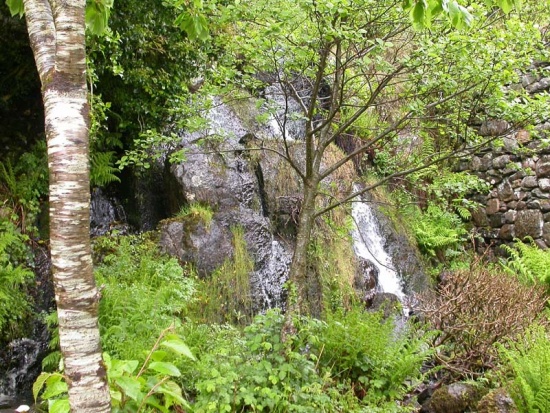Overview
This National Nature Reserve and Biosphere Reserve lies on a spit of land on the western shore of Loch Sween and an inlet of the loch, Linne Mhuirich.
Much of the reserve is oak woodland with a scattering of Ash, Holly, Hawthorn and Rowan and Birch around woodland edges and glades and Willow and Alder in the wetter areas. This is one of the largest areas of this once widespread habitat left in Scotland.
Birds
Notable Species
The woodland and scrub are home to Eurasian Sparrowhawk, Common Buzzard and Tawny Owl, Woodcock, Green Woodpecker and Great Spotted Woodpecker and Treecreeper.
Summer visitors to the area include Common Cuckoo, Common Redstart, Tree Pipit and Spotted Flycatcher as well as warblers such as Grasshopper Warbler, Garden Warbler, Wood Warbler and Willow Warbler. The conifers have Goldcrest, Siskin, Lesser Redpoll and Common Crossbill.
On and around the smaller freshwaters there are Little Grebe, Grey Heron, Common Teal and Reed Bunting.
The sea-loch and Linne Mhuirich in summer host Red-throated Diver, Common Eider, Red-breasted Merganser and Common Shelduck, Oystercatcher, Ringed Plover and Eurasian Curlew. The southern part of Linne Mhuirich attracts passage and wintering species such as Whooper Swan, Barnacle Goose and Greater White-fronted Goose and Eurasian Wigeon as well as other waterfowl and various waders. Great Northern Diver and Black-throated Diver occur in winter.
Check-list
Birds you can see here include:
Red-throated Diver, Black-throated Diver, Great Northern Diver, Little Grebe, Slavonian Grebe, Great Cormorant, European Shag, Grey Heron, Mute Swan, Whooper Swan, Greater White-fronted Goose, Barnacle Goose, Common Shelduck, Eurasian Wigeon, Common Teal, Mallard, Common Pochard, Tufted Duck, Common Eider, Long-tailed Duck, Common Scoter, Common Goldeneye, Red-breasted Merganser, Hen Harrier, Eurasian Sparrowhawk, Common Buzzard, Common Kestrel, Peregrine Falcon, Common Pheasant, Water Rail, Common Moorhen, Eurasian Coot, Eurasian Oystercatcher, Ringed Plover, Northern Lapwing, Dunlin, Eurasian Woodcock, Whimbrel, Eurasian Curlew, Common Redshank, Common Greenshank, Common Sandpiper, Ruddy Turnstone, Arctic Skua, Black-headed Gull, Common Gull, Lesser Black-backed Gull, Herring Gull, Great Black-backed Gull, Common Woodpigeon, Eurasian Collared Dove, Common Cuckoo, Barn Owl, Tawny Owl, Green Woodpecker, Great Spotted Woodpecker, Eurasian Skylark, Sand Martin, Barn Swallow, Northern House Martin, Tree Pipit, Meadow Pipit, Rock Pipit, Grey Wagtail, Pied Wagtail, Common Wren, Dunnock, Eurasian Robin, Common Redstart, Whinchat, European Stonechat, Northern Wheatear, Eurasian Blackbird, Fieldfare, Song Thrush, Redwing, Mistle Thrush, Common Grasshopper Warbler, Sedge Warbler, Common Whitethroat, Garden Warbler, Blackcap, Wood Warbler, Common Chiffchaff, Willow Warbler, Goldcrest, Spotted Flycatcher, Long-tailed Tit, Coal Tit, Blue Tit, Great Tit, Common Treecreeper, Common Jay, Common Magpie, Eurasian Jackdaw, Hooded Crow, Northern Raven, Common Starling, House Sparrow, Chaffinch, European Greenfinch, European Goldfinch, Eurasian Siskin, Eurasian Linnet, Lesser Redpoll, Common Crossbill, Common Bullfinch, Yellowhammer, Reed Bunting
Other Wildlife
To do
Site Information
History and Use
To do
Areas of Interest
As well as the woodland there are also meadows and coastal grasslands and the shallow freshwater Lochan Taynish.
Loch Sween is a long narrow sea-loch with rocky shores and extensive conifer plantations at the head.
The small freshwater Loch Coille-Bahrr lies to the north of the head of Loch Sween and the eastern shore, around Achnamara particularly, are intertidal zones where estuarine birds can be seen.
The inlet of Linne Mhuirich is linked to Loch Sween by a narrow channel of tidal rapids and at its southern end, An Grianan, there is a brackish pool which attracts passage waterfowl.
Access and Facilities
To reach Loch Sween take the B8025 Bellanoch to Keillmore road and turn off 3km south of Bellanoch, park close to Loch Coille-Bharr.
To reach the Taynish NNR return to the B8025 and turn left onto a track just south of Tayvallich. Follow the track to Lochan Taynish where there is a car-park and continue on foot towards Taynish House.
Linne Mhuirich can be viewed from further south on the B8025.
Contact Details
To do
External Links
Content and images originally posted by Steve





